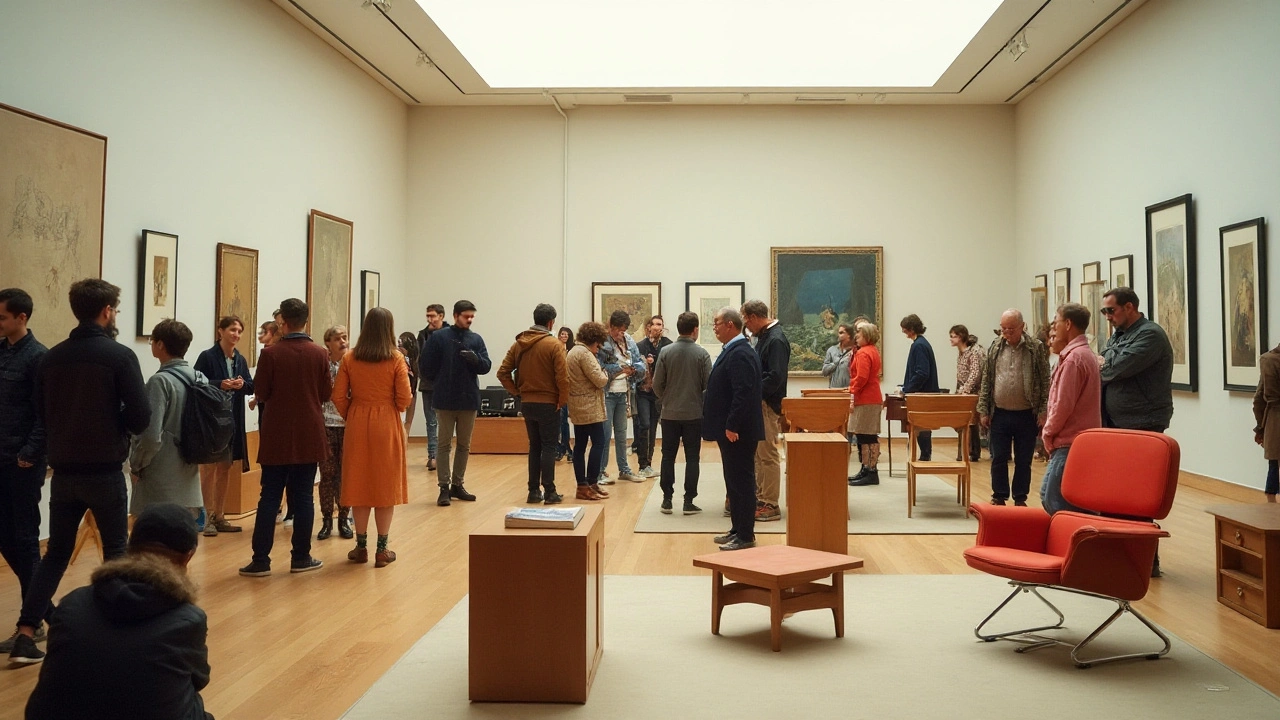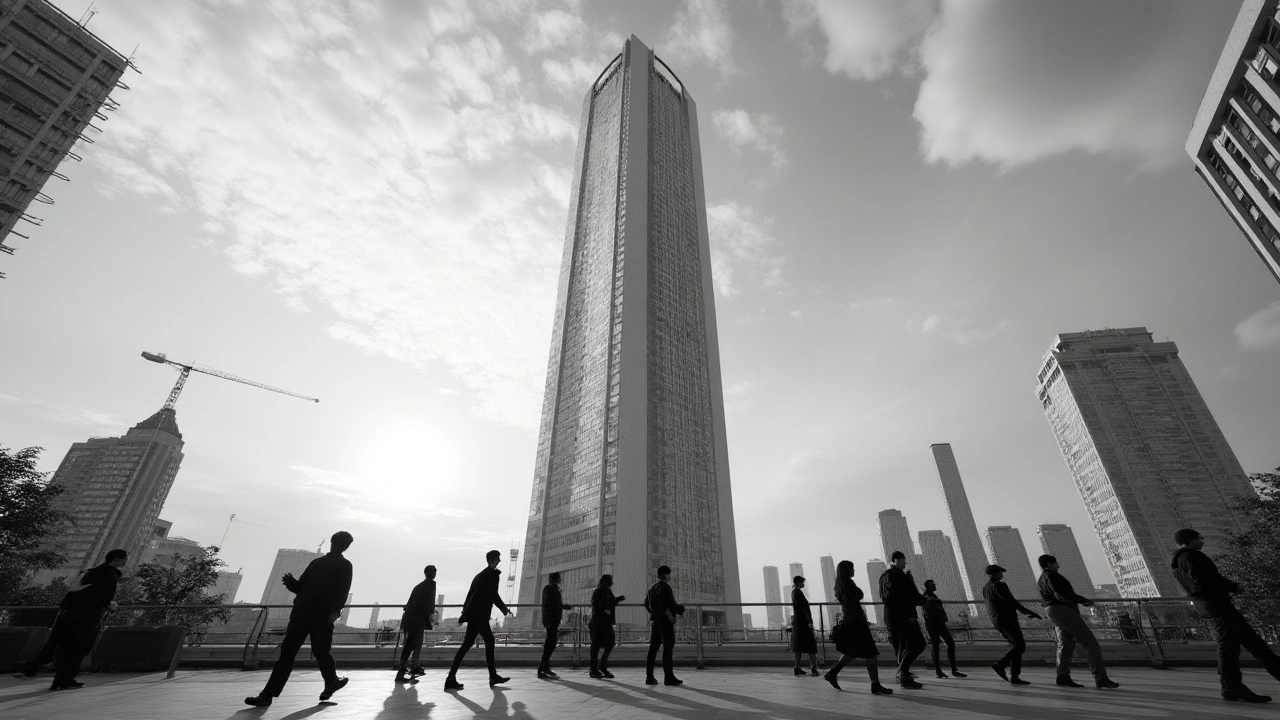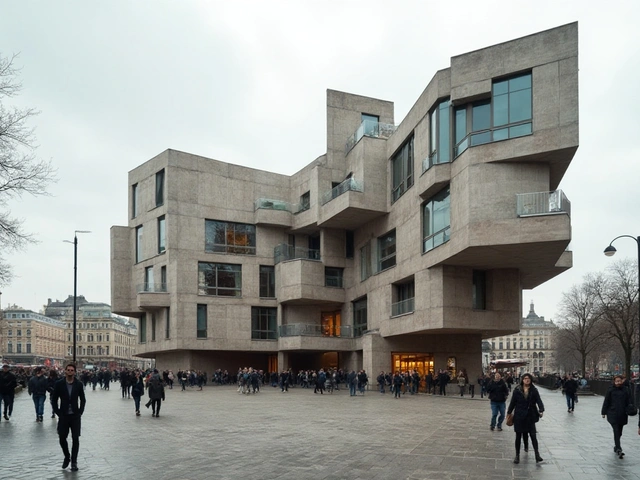The International Style represents a fascinating chapter in the story of art and architecture. Emerging in the early 20th century, this design movement emphasized clean lines, functional forms, and an absence of unnecessary decoration. It was innovative in its approach, creating a global language in the field of creative design.
Rooted in Europe yet quickly spreading across the globe, the International Style found its way into many facets of both architecture and everyday objects. Its legacy is seen in the structures and artworks that continue to inspire designers and architects worldwide.
In this exploration, we will uncover how this style began, examine its defining traits, and celebrate the influential figures who propelled it to fame. From towering skyscrapers in America to modernist homes in Japan, the International Style has left a lasting impression on our visual landscape.
- Origins and Evolution of the International Style
- Defining Characteristics
- Influential Figures and Iconic Works
- Global Adaptations and Variations
- Critiques and Controversies
- Legacy and Influence in Modern Design
Origins and Evolution of the International Style
The birth of the International Style can be traced back to the early 1920s, when the world was still reeling from the devastation of World War I. This was a period when architects and artists were seeking to break away from past traditions and create something new that transcended cultural boundaries. The term itself was coined by Henry-Russell Hitchcock and Philip Johnson for a 1932 exhibition at the Museum of Modern Art in New York. It was there that they presented and formalized this architectural approach that emphasized the volume of space rather than mass, pure forms, and the use of modern materials.
Emerging prominently from Europe, particularly Germany's Bauhaus and the Dutch De Stijl movement, the International Style quickly became a symbol of modernity. Architects like Walter Gropius, Le Corbusier, and Ludwig Mies van der Rohe became its champions, pioneering the use of steel and glass in buildings. These materials allowed for open floor plans and expansive windows that invited natural light into spaces. As cities rebuilt after the war, this style offered practicality and a vision for a better, more unified future.
"Less is more," proclaimed Mies van der Rohe, capturing the essence of this style's philosophy.
As the political climate in Europe became hostile with the rise of fascism, many key figures of the International Style emigrated to the United States, further spreading influence. In the post-war era, it became the leading expression for institutional buildings—notably office skyscrapers—in the booming urban expansion. Its hallmark was minimalism, found in both architecture and art, rejecting unnecessary embellishments in favor of stronger, clearer forms.
The Impact on Global Architecture
The global reach of the International Style was remarkable. As countries sought modernization in the mid-twentieth century, many found its straightforward design language aligned well with functional needs. This was especially evident in developing cities where efficient space usage and cost-effective design were vital. In Asia, cities like Tokyo and Mumbai embraced these ideals, fusing them with local traditions to birth distinctive architectural expressions.
Yet, the popularity also gave rise to criticism, with some arguing it led to the homogenization of cities, as many buildings began to look alike regardless of their location. Critics felt this could strip away cultural identities, a debate that continues to echo. Despite such criticisms, the International Style undeniably paved the way for the global architecture we see today.
By understanding the cultural and historical context in which this style emerged, one gains insight into how it became a universal language in design. It wasn't just about aesthetics; it was about expressing a commitment to progress and the belief that art and architecture could improve human life. This exploration reveals how the International Style has become more than just a movement—it's a testament to the transformational power of design.
Defining Characteristics
The International Style is marked by several distinct attributes that fundamentally shifted the way architecture and design were perceived in the 20th century. One of its primary tenets is the emphasis on functionality over form, a stark departure from the ornate and decorative approaches that preceded it. This movement celebrated simplicity, with buildings characterized by clean lines and open spaces that foreground the notion of form following function.
Architects like Le Corbusier, Walter Gropius, and Ludwig Mies van der Rohe were at the forefront of this style, advocating for structures that were not just visually appealing but also practical. Buildings were often constructed using modern materials such as steel, glass, and concrete to create what is often described as a 'machine for living'. The use of glass facilitated vast, open spaces that integrated the environment outside, blurring the line between the interior and exterior. This approach wasn't just about aesthetics; it was a move towards buildings that could serve the needs of modern life. This shift had a profound impact, altering the skyline of cities around the world.
Another defining feature is the absence of ornamentation. In stark contrast to previous eras like the Baroque or the Gothic, which favored elaborate decorations, the International Style preached restraint and minimalism. This philosophy is perhaps best encapsulated by Mies van der Rohe's famous dictum, “Less is more”. This mantra underscored a desire to strip away excess and focus on clarity and purity of design. The result is an architectural form that is sleek and unadorned, where aesthetic beauty arises from the integrity of its structure and the efficiency of its function.
The spatial flexibility of International Style buildings was another groundbreaking concept. Floor plans were open and adaptable, often supported by a skeleton frame construction which allowed for the removal of load-bearing walls inside. This created spaces that could be easily reconfigured to suit changing needs, embodying a fluidity that complemented modernism’s affinity for progress and adaptability. Such an approach facilitated innovations in interior design, permitting an unprecedented degree of customization and personal expression within a framework of geometric precision and harmony.
International Style was not solely confined to architecture; it influenced a variety of design disciplines, from graphic arts to industrial design. In all these fields, the core principles of simplicity, functionalism, and rationalization were upheld. These characteristics resonated with the modern worldview, which increasingly valued speed, efficiency, and technological advancement. As the world became smaller due to globalization, the uniform look of International Style symbolized a shared modern identity that transcended national boundaries.
Critics of the International Style have argued that its stark uniformity led to soulless urban environments, devoid of cultural specificity or warmth. Yet, this criticism is but a testament to the style’s pervasive reach and its bold challenge to tradition. Despite its controversies, the International Style remains a watershed moment in design history, an era where the shared aspiration was to create a new world, clean and bright in its simplicity, echoing a quote by Gropius:
"The ultimate aim of all creative activity is the building!"
Influential Figures and Iconic Works
Delving into the rich history of the International Style, it's impossible to ignore the remarkable contributions of certain visionary architects and artists who shaped its progression. One such luminary is Le Corbusier, often hailed as a pioneer of modern architecture. His designs emphasized open spaces, light, and functionality, with structures like the Villa Savoye showcasing these principles beautifully. The villa, located in Poissy, France, embodies the style's minimalistic elegance, featuring a seamless interaction between indoor and outdoor environments. It’s through such works that Le Corbusier established the tenets of an architectural revolution that aimed at breaking away from the ornate styles of the past.
Another towering figure of the International Style is Ludwig Mies van der Rohe. Known for the aphorism “less is more,” Mies van der Rohe's approach to design was one of effortless simplicity and reduced forms. His work on the Seagram Building in New York remains a testament to the style's enduring appeal. This skyscraper’s sleek façade with dark bronze tinting and uniform structure became a blueprint for countless modern buildings worldwide. It's interesting to note how the deliberate choice of materials and the building’s minimalist aesthetic underscored a commitment to precision and restraint, setting new standards in urban architecture.
Amongst these influential figures, the contributions of Walter Gropius cannot be overlooked. As the founder of the Bauhaus School, Gropius encouraged a fusion of art, design, and architecture, promoting a uniform style that eschewed ornamentation for function. One of his iconic works, the Bauhaus building in Dessau, stands as a beacon of the style. It combined industrial techniques with artistic sensibility, forming an architecture that still feels fresh and avant-garde even today. The movement he initiated extended its impact globally, cementing the International Style as a significant force reshaping environments across continents.
Beyond Architecture: Influential Artists
The International Style was not limited to architecture; it extended into the arts, influencing creatives across various disciplines. Artists such as Piet Mondrian embraced the movement's aesthetic, incorporating its principles into the visual arts. Mondrian's famous composition paintings, with grids of vertical and horizontal lines intersecting in primary colors, echo the style's affinity for precision and abstraction. These works have been celebrated for their simple yet profound visual impact, capturing the essence of the modernist spirit that the International Style epitomized.
Similarly, in the sphere of furniture design, the contributions of architect and designer Marcel Breuer stand notable. His innovative use of materials, particularly in the Wassily Chair, was revolutionary. Employing tubular steel, Breuer created a piece that was not only functional and comfortable but also visually striking in its simplicity – a hallmark of the style. Breuer’s works symbolize a significant shift in design thinking, emphasizing that utility could coexist harmoniously with aesthetic appeal.
"Architecture is the masterly, correct, and magnificent play of masses brought together in light." – Le Corbusier
These figures and their iconic works demonstrate how the International Style transcended its initial geographic confines, from Europe to the Americas, infusing modern design and architecture with a legacy that endures to this day. Their contributions were not just about creating structures and artworks but about fostering a global design language that continues to influence and inspire subsequent generations of artists and architects.
Global Adaptations and Variations
The reach of the International Style is one of its most remarkable aspects, transcending geographical boundaries and influencing a multitude of cultures. Originally emerging in Europe, architects such as Le Corbusier and Walter Gropius laid down principles that would soon capture the imagination of designers worldwide. As this style traveled, it mingled with local traditions and technologies, sometimes bending to the cultural contexts it encountered. One such adaptation can be observed in Japan, where the minimalist and functional nature of the style harmonized beautifully with traditional Japanese aesthetics. A blend of the old and new, Japanese architects like Kenzo Tange ingeniously married functional modernism with historical elements, crafting spaces that were both universal and uniquely Japanese.
Interestingly, the journey of the International Style across the globe didn't just lead to uniformity but often to inventive regional variations. As America witnessed a surge in its adoption, especially during the post-war boom, skyscrapers became its hallmark. Architects like Philip Johnson and Ludwig Mies van der Rohe ushered in an era where clean, soaring glass and steel structures redefined urban spaces. However, this wasn't a mere copy-paste of the European ethos. Instead, the American iteration embraced the burgeoning corporate identity and technological advancements, resulting in edifices that stood as symbols of international business prowess.
"Architecture should speak of its time and place, but yearn for timelessness."— Frank Gehry
In contrast, Latin America saw the International Style manifest in vibrant and unexpected ways. Brazil, under the visionary guidance of Oscar Niemeyer, took modernism and infused it with expressive curves, drawing from the nation's topography and lively culture. His seminal work in the design of Brasília exemplifies how the ethos of the International Style can be both rigorously modern yet flamboyantly personal. Such adaptations were not just superficial but deeply rooted in the socioeconomic and cultural fabric of these regions. The tropical climates, available materials, and even political contexts all played pivotal roles in shaping these local renditions.
Yet, not all adaptations were widespread or even fully embraced. In some areas, the style met with resistance, as traditionalists feared the loss of cultural identity to a perceived 'Western' approach to architecture. This led to hybrid styles that interwove the DNA of the International Style with local artistic expression. Conversely, nations facing rapid urbanization, like China in the late 20th century, interpreted the International Style to suit their city-building needs, emphasizing efficiency and scalability over the artistry often associated with European modernism.
The resonance of the International Style can be measured not just in its omnipresence but in the way it encouraged dialogue between cultures. It challenged architects worldwide to rethink the relationship between form and function, often prompting creative local solutions. Even today, one can trace its influence in contemporary design, where global connectivity calls for an architectural language that is both unifying and diverse. It seems evident that the transformations and adaptations of this style continue to build bridges across different cultures, reflecting an ever-changing and interconnected world.
| Region | Key Adaptation | Notable Architect |
|---|---|---|
| America | Skyscrapers and corporate identity | Philip Johnson |
| Japan | Minimalism meets tradition | Kenzo Tange |
| Brazil | Expressive curves and local materials | Oscar Niemeyer |

Critiques and Controversies
The International Style, while celebrated for its forward-thinking approach to design, did not escape criticism and controversy. Detractors of the style argue that its focus on simplicity and function often comes at the expense of cultural identity and expression. The minimalist aesthetics can sometimes make buildings appear cold and impersonal, sparking debates about their impact on community spaces and social interaction. In urban environments, cookie-cutter International Style structures can lead to a sense of uniformity that lacks character and fails to reflect the unique tapestry of the locale. Critics suggest this approach prioritizes form over context, resulting in designs that could be placed anywhere in the world without a nod to their surroundings.
Significant voices in architecture have shared their thoughts on this matter. The renowned architect Charles Jencks famously criticized the style for its perceived sterility. He pointed out that while the style aimed to break new ground by erasing unnecessary ornamentation, it sometimes took away the warmth and richness that decorated elements could provide. Jencks argued that by stripping design down to its bare essentials, the International Style risked losing the personal touch so valued in residential architecture.
Another part of the controversy around the International Style involves its association with industrialization. The emphasis on functionality and mass production paralleled the rise of factories and urban sprawl in the 20th century, leading some to critique it as a catalyst for environmental neglect. The wide use of concrete and steel, materials emblematic of the style, has been linked to the environmental impacts of construction. This has prompted dialogues about sustainable practices and the ecological responsibilities of architects adhering to this style.
While some of the criticisms highlight valid concerns, it's important to acknowledge the balance the International Style attempted to strike between art and functionality. Many renowned architects have taken these critiques to heart, adapting their methods to create harmonious designs that encompass the style's ideals while addressing its shortcomings. This ongoing evolution showcases the style's enduring relevance and its ability to adapt to the changing needs and values of society.
Today, modern architects often blend International Style principles with contextual and sustainable factors, proving that even though some aspects are controversial, the underlying philosophy remains influential. The style's roots in simplicity and utility are still valued, but the challenge lies in integrating these with modern demands for environmentally sensitive and culturally resonant designs. As our world continues to change, so too does the conversation around the International Style, ensuring that it remains a topic of lively discussion in design circles worldwide.
Legacy and Influence in Modern Design
When we talk about the International Style and its influence, we're not just reminiscing about the past; we're acknowledging its living presence in contemporary design. This movement, which initially astonished audiences with its groundbreaking simplicity and functional elegance, has left an indelible mark on how spaces and objects are conceived today. The clean and uncluttered lines found in modern homes, offices, and public buildings are direct descendants of this style's core principles. And its influence doesn't stop with architecture; product design, graphic design, and even the way we approach urban planning have been transformed by its ideas.
Today, the streamlined aesthetic pioneered by the International Style continues to embody a universal appeal, pushing boundaries while respecting the framework it established. Innovations in design now frequently draw from its principles, adapting to contemporary needs yet maintaining that connection to simplicity and purpose. For instance, the rise of minimalist interior design or the glass-and-steel facades seen on many skyscrapers reflect the continued relevance of this style. A quote by the great architect, Mies van der Rohe, "Less is more," still resonates strongly within the ethos of many modern designers striving to achieve beauty through reduction.
The Digital Influence
As technology evolves, so does design. The principles of the International Style often find their way into digital spaces as well. Websites and digital interfaces frequently mimic the movement's emphasis on usability and minimalism, recognizing that a well-designed product effectively communicates without unnecessary complexity. This has been particularly instrumental in the age of apps and digital interaction, where clarity and seamless user experiences are vital.Modern architects and designers often celebrate iconic works of the International Style, drawing inspiration for new projects that echo its timeless elegance. For example, Le Corbusier's Villa Savoye or the Seagram Building by Ludwig Mies van der Rohe and Philip Johnson still serve as instructional material for design students around the world. Their works offer valuable lessons in balance, structure, and the fascinating dialogue between form and function. In architecture schools across the globe, students meticulously study these structures, understanding how their creators skillfully balanced proportion and space to enhance human interaction within these environments.
The style's influence has also permeated a wide range of cultural facets. Fashion, for instance, often parallels the simplicity and modernism at its core. In the same way that these buildings stand timelessly, garments with clean lines and neutral palettes seem to transcend seasons and trends. Even in music, there’s an analogy; minimalist compositions prioritize essence over embellishment, much like the International Style prioritizes form over frivolity.





